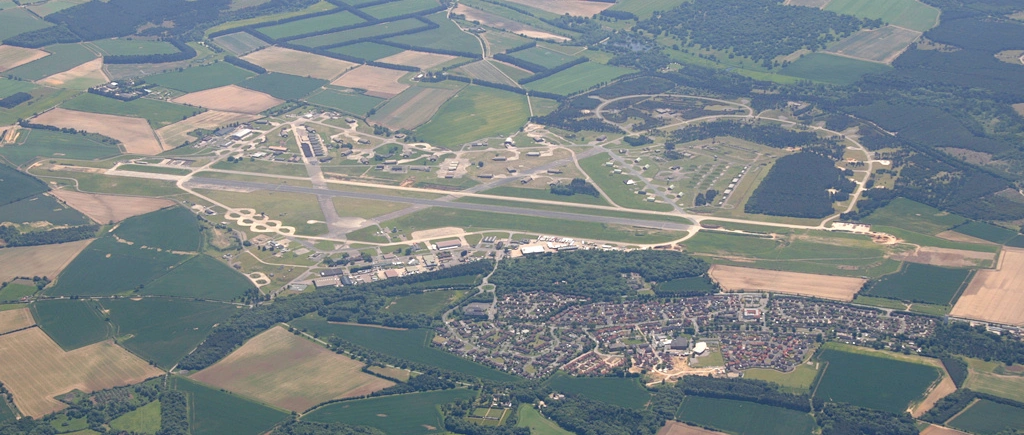Royal Air Force Bentwaters is a former Royal Air Force station about 80 miles northeast of London and 10 miles east-northeast of Ipswich in England. Its name was taken from ‘Bentwaters Cottages’ that had stood on the site of the main runway during its construction in 1943.
It was used by the Royal Air Force (RAF) during the Second World War, and by the United States Air Force (USAF) during the Cold War, being the primary home for the 81st Fighter Wing under various designations from 1951 to 1993. For many years the 81st Fighter Wing also operated RAF Woodbridge, with Bentwaters and Woodbridge airfields being known by the Americans as the “Twin Bases”.
The site is now known as Bentwaters Parks. The Bentwaters Cold War Museum is located on the site, there are offices and warehouses, and the site is also used for television and film making.
Second World War
Bentwaters airfield’s origin dates to 1942 when construction began on a Royal Air Force station called Royal Air Force Butley for use by RAF Bomber Command. On 28 January 1943 the station was renamed Royal Air Force Bentwaters. It was opened for operational use in April 1944. In December it was transferred to No. 11 Group, RAF Fighter Command.
In addition to its RAF use, United States Army Air Forces (USAAF) fighters flew escort missions for RAF Bomber Command from Bentwaters beginning on 4 May 1945. The USAAF designation for Bentwaters was AAF Station 151.
During the postwar years, the RAF retained Bentwaters for flying various aircraft, including first-generation jet aircraft. before finally closing the facility on 26 August 1949 when it was placed into ‘care and maintenance’ status.
Control of Bentwaters was transferred to the United States Air Force on 16 March 1951 by the Ministry of Defence, and the United States Air Forces in Europe (USAFE) designated it a primary installation of HQ USAFE on 7 September 1951. Bentwaters was to play a key role in the defence of Western Europe during the Cold War when large numbers of USAF aircraft were assigned as part of the air arm of NATO.
The 81st Fighter-Interceptor Wing became the new host unit at Bentwaters in September 1951. The 81st, in various designations, remained at RAF Bentwaters for over 40 years during the Cold War era. The 81st FIW was a North American F-86A “Sabre” equipped unit, being activated at Moses Lake AFB, Washington in May 1950. In August 1951 the 81st flew initially into RAF Shepherds Grove, then in September transferred its headquarters to RAF Bentwaters.
Post Cold War
With the end of the Cold War, the USAF presence at Bentwaters was gradually phased down. It was announced that the station would be closed and the 81st TFW would be deactivated.
The last A-10 aircraft departed Bentwaters on 23 March 1993, and the 81st Tactical Fighter Wing was inactivated on 1 July 1993. With the inactivation, the USAF returned control of Bentwaters to the Ministry of Defence.
Currently, Bentwaters airfield is inactive as a military facility.
Bentwaters Cold War Museum
With the handover of Bentwaters back to the UK Ministry of Defense in 1993, the facility was closed. It is now known as “Bentwaters Parks”.
In 2003, work commenced on the Bentwaters Cold War Museum (BCWM). The museum opened on Sunday 27 May 2007. The museum is located in the former USAF hardened command post. The main “war operations room” and “Battle cabin” have been restored to their original condition; the BT telephone exchange room, decontamination showers, and airlock have been similarly restored. Other rooms within the building have been turned into exhibition rooms, covering the history of RAF Bentwaters from the Second World War until the station closed in 1993.
Included in this are histories of the units that operated from the airfield, particularly the 81 TFW. Another room is dedicated to the history of the other airfield which was part of the “twin base” complex, RAF Woodbridge, again covering the period from the Second World War until the present day. Other exhibition rooms featuring information on the “Special Operations/Rescue Squadrons” that were based at RAF Woodbridge, and also the “Aggressor” Squadron based at Bentwaters.
The museum is run by volunteers from Bentwaters Aviation Society.
Click here to visit the Bentwaters Cold War Museum.

